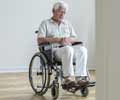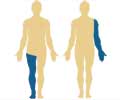A family in Varanasi is struggling to nurture a cerebral palsy affected youth.
Attending to 21-year-old Shafaq since childhood has taken a toll on this poor family, as the father struggles to somehow arrange for the two square meal.But disappointment overwhelms Hamid whenever he thinks how all his efforts for son's cure and care haven't been of much help.
Hamid, who is a weaver, has already sold off all his valuables to ensure treatment for Shafaq. But he finds his all efforts made so far have been in vain because the son hasn't improved much.
"He was born in 1989 and it was a premature delivery at eight-and-a-half months. He was very weak. I have sold jewellery and other valuables for his treatment but it was of no use," says Abdul Hamid, the father.
Shafaq's mother Rahita Bano devotes her entire day attending to him but at times breaks down to notice son's helplessness
Shafaq's only intake is milk that he drinks about three litres everyday.
Advertisement
"This disease can be contacted even when the child is in the womb and also after the delivery. If the disease is contacted after the delivery it is curable but if the child has contacted the disease when in the womb, there is no specific treatment for it," said Dr. O P Mishra, a neurologist.
Advertisement
"The disease is usually seen among the impoverished families where the pregnant women could not go through proper medical check up for want of money," added Dr. Mishra.
Cerebral palsy can't be cured, but treatment including physical and occupational therapy, speech therapy, drugs to control seizures, relax muscle spasms, and alleviate pain; surgery to correct anatomical abnormalities and communication aids such as computers with attached voice synthesizers improves a child's capabilities. By Girish Kumar Dube
Source-ANI
RAS











